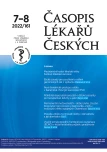-
Medical journals
- Career
Practical recommendations for the management of children after kidney and liver transplantation
Authors: Jakub Zieg 1; David Bauer 2; Vlasta Krejčová 1; Lucie Gonsorčíková 2
Authors‘ workplace: Pediatrická klinika 2. LF UK a FN Motol, Praha 1; Pediatrická klinika 1. LF UK a FTN, Praha 2
Published in: Čas. Lék. čes. 2022; 161: 296-302
Category: Guidelines
Overview
The number of pediatric solid organ transplantations is growing. This therapy leads often to better quality of life but also brings some specific complications. Our review summarizes practical recommendations for long-time care of the children after kidney and liver transplantation. The knowledge of the issues related to transplantation is essential for the first contact physicians, whose cooperation with transplant centre contributes highly to adequate management of these children.
Keywords:
kidney transplantation – liver transplantation – adherence – sport – medication
Sources
1. Zieg J, Skálová S. Dětská nefrologie do kapsy. Mladá fronta, Praha, 2019.
16. Pham YH, Miloh T. Liver transplantation in children. Clin Liver Disease 2018; 22 : 807–821.
30. Dreno B. Skin cancers after transplantation. Nephrol Dial Transplant 2003; 18 : 1052–1058.
37. Bartosh S, Dipchand A, Chavers B, Pediatric Kidney Transplantation. A Guide for Patients and Families. American Society of Transplantation, 2015. Dostupné na: www.erknet.org/patient_info/Pediatric_Kidney_Transplantation_BrochureAST__-_final_copy_2015-06-27_0.pdf
Labels
Addictology Allergology and clinical immunology Angiology Audiology Clinical biochemistry Dermatology & STDs Paediatric gastroenterology Paediatric surgery Paediatric cardiology Paediatric neurology Paediatric ENT Paediatric psychiatry Paediatric rheumatology Diabetology Pharmacy Vascular surgery Pain management Dental Hygienist
Article was published inJournal of Czech Physicians

-
All articles in this issue
- ÚVODEM
- The International Code of Medical Ethics of the World Medical Association
- In 2022, a new version of the Code of Ethics was adopted by the World Medical Association (WMA) – what new features does it bring?
- Ethical principles for the usage and sharing of genomic data from research
- Indications for Metabolic and Bariatric Surgery – ASMBS/IFSO 2022
- Innovative Bariatric Procedures and Ethics in Bariatric Surgery: the IFSO Position Statement
- Practical recommendations for the management of children after kidney and liver transplantation
- Permanent urethral catheter – a good servant, but bad master: Guidelines for prevention, diagnosis, and treatment of catheter-associated urinary tract infections
- Prescription rules of hormone replacement therapy and its alternative
- Low levels of vitamin D in population exposed to significant environmental pollution
- The use of extracorporeal membrane oxygenation in the treatment of critical course of pneumonia
- COVID-19 infection elicits textbook immune response
- Trends in spa and balneology in postcovid era, outcomes, and perspectives
- The Fellowship of Czech Physicians in Prague and its activities in recent decades
- 160 years of Czech medicine through the prism of 16 jubilees of the Fellowship of Czech Physicians on the pages of the Journal of Czech Physicians
- Zemřel profesor Miroslav Ryska
- Journal of Czech Physicians
- Journal archive
- Current issue
- Online only
- About the journal
Most read in this issue- Permanent urethral catheter – a good servant, but bad master: Guidelines for prevention, diagnosis, and treatment of catheter-associated urinary tract infections
- COVID-19 infection elicits textbook immune response
- Prescription rules of hormone replacement therapy and its alternative
- The use of extracorporeal membrane oxygenation in the treatment of critical course of pneumonia
Login#ADS_BOTTOM_SCRIPTS#Forgotten passwordEnter the email address that you registered with. We will send you instructions on how to set a new password.
- Career

